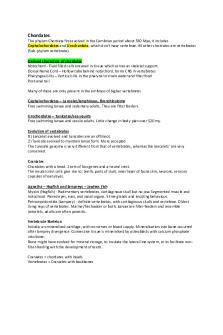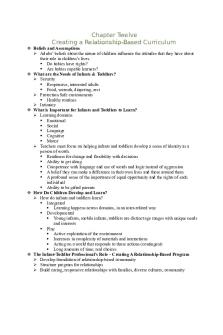Chapter 12 Reviewer - Lecture notes 12 PDF

| Title | Chapter 12 Reviewer - Lecture notes 12 |
|---|---|
| Course | Biology |
| Institution | Pontifical and Royal University of Santo Tomas, The Catholic University of the Philippines |
| Pages | 6 |
| File Size | 251.9 KB |
| File Type | |
| Total Downloads | 134 |
| Total Views | 332 |
Summary
ZOOLOGY LEC REVIEWER CHAPTER 12: SPONGES AND PLACOZOANSTHE ORIGINS OF MULTICELLULARITY Sponges -simplest multicellular animals -cells are embedded in extracellular matrix -supported by skeleton of minute needle-like spicules and protein12 ORIGIN OF ANIMALS (METAZOA)Metazoans -synonymous with “animal...
Description
ZOOLOGY LEC REVIEWER CHAPTER 12: SPONGES AND PLACOZOANS THE ORIGINS OF MULTICELLULARITY Sponges -simplest multicellular animals -cells are embedded in extracellular matrix -supported by skeleton of minute needle-like spicules and protein
12.1 ORIGIN OF ANIMALS (METAZOA) Metazoans -synonymous with “animal” Choanoflagellates -solitary or colonial aquatic eukaryotes -each cell carries a flagellum surrounded by a collar of microvilli -many are sessile and attached to hard surfaces Choanocytes -sponge feeding cells -collared cell used in filter-feeding -flagellated cells without collars develop into choanocytes after larval metamorphosis Members of Placozoa -have smallest nuclear genome and largest mitochondrial genome
12.2 PHYLUM PORIFERA: SPONGES Choanocyte -flagellated “collar cell” -moves water -brings in food and oxygen, carries away wastes
CHARACTERISTICS OF PHYLUM PORIFERA 1. Multicellular; some of which are organized into incipient tissues with some integration. 2. Body with pores (ostia), canals, and chambers that form a unique system of water currents on which sponges depend for food and oxygen 3. Mostly marine; all aquatic 4. Radial symmetry or none 5. Outer surface of flat pinacocytes; most interior surfaces lined with flagellated collar cells (choanocytes) that create water currents; a gelatinous protein matrix called mesohyl contains amebocytes of various types and skeletal elements 6. Skeletal structure of fibrillar collagen (a protein) and calcareous or siliceous crystalline spicules, often combined with variously modified collagen (spongin); type IV collagen, characteristic of other animals, occurs only in homoscleromorph sponges. 7. No organs or true tissues; digestion intracellular; excretion and respiration by diffusion 8. Reactions to stimuli apparently local and independent in cellular sponges, but electrical signals in syncytial glass sponges; nervous system probably absent 9. All adults sessile and attached to substratum 10. Asexual reproduction by buds or gemmules and sexual reproduction by eggs and sperm; free-swimming flagellated larvae in most
-embryos are free-swimming -adult sponges are always attached
Microvilli -fingerlike projections
Commensals -one benefits, one is unaffected Crabs Nudibranchs Mites Bryozoans
Suspension feeding -collects suspended food particles from the surrounding water
Sponges also grow on many other living animals Molluscs Barnacles Brachiopods Corals Hydroids
Phagocytosis -engulfment of a particle by a phagocyte or unicellular eukaryote Pinocytosis -choanocytes acquire protein molecules -fluid acquisition by a cell -specific receptors bind ions/molecules present on plasma membranes—invaginated and pinch off to form small vesicles
Effective against Leishmaniasis -disease caused by kinetoplastan parasite
TYPES OF CANAL SYSTEMS
Herpetic infections -Skeletal framework Rigid o Consists of calcareous or siliceous support structures o Spicules Fibrous o Collagen protein fibrils in the intercellular matrix of sponges o Spongin
ASCONOIDS—Class Calcispongiae Choanocytes lie in a large chamber called spongocoel—central cavity in sponges Simplest organization Sponge draws water inside through microscopic dermal pores—beating large numbers of flagella on the choanocytes Choanocytes line the internal cavity— spongocoel o Choanocytes filter water and extract food particles from it Used water is expelled through a single large osculum
FORM AND FUNCTION Sponges feed primarily by collecting suspended particles from water pumped through internal canal systems Pinacoderm -outer layer of cells (pinacocytes) in sponges Dermal ostia -incurrent pores Choanocytes -where food particles are collected in a choanocyte collar
-small and tube-shaped Example: Leucosolenia Clathrina SYCONOIDS—Class Calcispongiae and Hexactinellida Choanocytes lie in canals Have tubular body and single osculum—but body wall (spongocoel lining) is thicker and more complex Lining—folded outward to make choanocyte-lined canals Water enters syconoid through dermal ostia leading to incurrent canals
Filters through tiny openings—prosopyles (connection between incurrent and radial canal) Radial canal—choanocyte-lined canals Food is ingested by the choanocytes Beating of choanocytes’ flagella forces the used water through internal pores— apopyles into the spongocoel Exits the body through an osculum— excurrent opening
Example: Sycon Development: Syconoid sponges were derived from an ancestor with an asconoid body plan LEUCONOIDS—Class Calcispongiae Choanocytes occupy distinct chambers -considered the major plan for sponges (most common) Most complex—permits an increase in sponge size Choanocytes line the walls of small chambers where they can effectively filter all water present Clusters of flagellated chambers are filled from incurrent canals and discharge water into excurrent canals that eventually lead to osculum Example: Leuconia
TYPES OF CELLS IN THE SPONGE BODY Mesohyl -gelatinous matrix surrounding sponge cells Mesenchyme -embryonic connective tissue
Choanocytes -line flagellated canals and chambers -create water currents and engulf food particles
-ovoid cells with one end embedded in mesohyl— other end exposed -exposed end bears a flagellum surrounded by a collar -intracellular digestion -also have a role in sexual reproduction Archaeocytes -ameboid cells that move in the mesohyl -perform a number of functions -can phagocytize particles at the pinacoderm and receive particles for digestion from choanocytes Sclerocytes—secrete spicules Spongocytes—secrete spongin fibers Collencytes—secrete fibrillar collagen Lophocytes—secrete large quantities of collagen Pinacocytes -protective and contractile -thin, flat, epithelial-like cells -cover the exterior surface and some interior surfaces of a sponge -incipient tissue -can ingest food particles by phagocytosis Myocytes o Modified pinacocyte o Usually arranged in circular bands around oscula or pores o Help regulate rate of water flow
CELL INDEPENDENCE: REGENERATION AND SOMATIC EMBRYOGENESIS Regeneration -ability to repair injuries and restore lost parts Somatic embryogenesis -asexual reproduction that involves a complete reorganization of structure and functions of participating cells or bits of tissue
Fragmentation -asexual -sponge breaks into parts that are each capable of becoming a new sponge
-develops with flagellated cells toward the interior Budding / Bud formation -external buds become detached from the parent and float away to form new sponges or may remain to form colonies Gemmules -internal buds formed in freshwater sponges and some marine sponges -mechanism for survival of the harsh conditions Micropyles -cell openings in which cells emerge from a gemmule and develop into new sponges SEXUAL REPRODUCTION Monoecious -having both male and female sex cells in one individual Sperm arises from transformation of choanocytes In Calcispongiae and some Demospongiae —oocytes also develop from choanocytes Other demosponges—gametes are derived from archaeocytes
Most sponges are viviparous After fertilization, zygote is retained in and derives nourishment from its parent— ciliated larva is released Choanocytes -phagocytize the sperm -transform into carrier cells -carry sperm through mesohyl to oocytes Other sponges are oviparous both oocytes and sperm are expelled into surrounding water
Parenchymula -free-swimming, flagellated, solid-bodied larva of most sponges Stomoblastula -hollow blastula
Inversion -blastula turning inside out Micromeres -flagellated cells of the amphiblastula larva at the anterior end -become choanocytes, archeocytes, and collencytes Macromeres -large, non-flagellated cells at the posterior end -give rise to pinacoderm and sclerocytes TAXONOMY OF PHYLUM PORIFERA Class Calcispongiae -spicules of calcium Sycon carbonate Leucosolenia -often form a fringe Clathrina around osculum (main water outlet) -needle-shaped or 3 or 4rayed -all three types of canal systems -all marine Class Hexactinellida -6-rayed -siliceous spicules (Hyalospongiae) -often united to form Euplectella Hyalonema network -body often cylindrical or funnel-shaped -syconoid or leuconoid -habitat mostly deep water -all marine Class -siliceous spicules Demospongiae -leuconoid-type Amphimedo -one family found in n freshwater (SPongillidae) Cliona -all others are marine Spongilla Myenia Poterion Callyspongia All bath sponges Class -previously subgroup of Homoscleromorpha demospongiae
Plakina Oscarella Corticium
-spicules may be absent (Oscarella) -spicules present: small, simple, do not form around axial filament -pinacoderm: distinct basement membrane
CLASS CALCISPONGIAE Leucosolenia o Small asconoid sponge o Grows in branching colonies o Usually arising from a network of horizontal, stolonlike tubes Clathrina o Small with intertwined tubes Sycon o Solitary sponge o May live singly or form clusters by budding CLASS HEXACTINELLIDA (HYALOSPONGIAE) GLASS SPONGES -syncytial tissue Syncytia -produce by fusion of many cells or by repeated divisions of a cell nucleus without division of cytoplasm Trabecular Reticulum -single, continuous syncytial tissue of the body of hexactinellid sponge -bilayered, can be sheetlike or tubular Choanoblasts -unusual cells that make two or more flagellated outgrowths called collar bodies Collar bodies -extensions of choanoblasts bearing flagellated collars Primary reticulum Secondary reticulum -lacks mesohyl CLASS DEMOSPONGIAE
-includes most large sponges -siliceous spicules Horny sponges -bath sponges -Spongia and Hippospongia -have spongin skeletons -lack siliceous spicules entirely
Pseudoceratina crassa o colorful sponge o growing at moderate depths Aplysina fistularis o Tall and tubular Monanchora unguifera o Commensal brittle star Ophiothrix suensoni o Phylum Echonodermata, Class Ophiuroidea
CLASS HOMOSCLEROMORPHA -more common in nearshore habitats Cadherins -protein that connects cells to each other in particular junctions called desmosomes Pinacoderm -incipient tissue PHYLOGENY AND ADAPTIVE DIVERSIFICATION PHYLOGENY Originated before the Cambrian period Phylum Porifera is paraphyletic ADAPTIVE DIVERSIFICATION Chondrocladia lyra o Deep sea harp sponge o Carnivorous sponge
12.3 PHYLUM PLACOZOA Trichoplax adhaerens o Platelike, has no symmetry, no organs, no muscular or nervous system
o Lacks both basal lamina and extracellular matrix o Diploblastic o has only two cell layers with a layer of fibrous syncytial cells between them -body is composed of dorsal epithelium of cover cells and shiny spheres and a thick ventral epithelium containing monociliated cells (cylinder cells) and noncilliated gland cells -space between epithelia contains multinucleate fibrous contractile cells -glide over their food, secrete digestive enzymes on it, then absorb the products...
Similar Free PDFs

Chapter 12 - Lecture notes 12
- 4 Pages

Chapter 12 - Lecture notes 12
- 9 Pages

Chapter 12 lecture notes
- 19 Pages

12 - Lecture notes 12
- 3 Pages

Lab 12 - Lecture notes 12
- 5 Pages

LEC 12 - Lecture notes 12
- 3 Pages

(12) Mistake - Lecture notes 12
- 8 Pages

Lecture notes, lecture 12
- 9 Pages
Popular Institutions
- Tinajero National High School - Annex
- Politeknik Caltex Riau
- Yokohama City University
- SGT University
- University of Al-Qadisiyah
- Divine Word College of Vigan
- Techniek College Rotterdam
- Universidade de Santiago
- Universiti Teknologi MARA Cawangan Johor Kampus Pasir Gudang
- Poltekkes Kemenkes Yogyakarta
- Baguio City National High School
- Colegio san marcos
- preparatoria uno
- Centro de Bachillerato Tecnológico Industrial y de Servicios No. 107
- Dalian Maritime University
- Quang Trung Secondary School
- Colegio Tecnológico en Informática
- Corporación Regional de Educación Superior
- Grupo CEDVA
- Dar Al Uloom University
- Centro de Estudios Preuniversitarios de la Universidad Nacional de Ingeniería
- 上智大学
- Aakash International School, Nuna Majara
- San Felipe Neri Catholic School
- Kang Chiao International School - New Taipei City
- Misamis Occidental National High School
- Institución Educativa Escuela Normal Juan Ladrilleros
- Kolehiyo ng Pantukan
- Batanes State College
- Instituto Continental
- Sekolah Menengah Kejuruan Kesehatan Kaltara (Tarakan)
- Colegio de La Inmaculada Concepcion - Cebu







